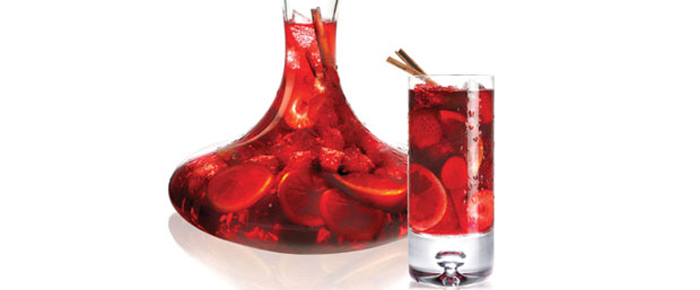
By Rick Riozza
Since we’re all dying out here in the heat, I thought all of us old wine guards (those of us who have been drinking wine forever but hate the idea of mixing in stuff—as in a wine cocktail) would relent and join the new young wine lovers among us and simply enjoy a chilled refreshing wine punch.
Actually, the Spanish and Portuguese—with all the hot weather of their own, have been enjoying a fruity wine punch for ages. And giving it the great nickname of “that bloody drink” or as the world knows it in Spanish: Sangria—simply adds to the fun.
No doubt what I’m writing about is not a news alert. Indeed! Sangria is caliente in the U.S. “We think bottled sangria is the next big thing in wine”, says Peter Deutsch CEO of Deutsch Family Wine & Spirits Co. (Yellow Tail, Georges Duboeuf, Josh Cellars, & more).
Wine Spectator magazine has reported, “The four leading bottled sangria brands grew 43 percent in the U.S. from 2010 to 2013. Yellow Tail Sangria expects to sell more than 200 percent more cases just this year. Gallo’s “Madria” sangria brand grew from 305,500 cases in 2010 to over 470,000 cases last year.”
I think everyone has seen the nation’s number one brand, Cruz Garcia Real Sangria, on the shelves with its colorful label and its iconic triangular shaped bottle. But prior to writing this article, I’ve never bought or even tried a bottle, being a little skeptical about a traditional “fresh fruit wine” being sold all bottled-up.
I mean—sangria is a wine punch you make with your left over dry red (or white) wine with slices of oranges, lemons, peaches, and maybe pineapple, limes, apples and berries along with some brandy and/or orange liqueur that’s all put into a pitcher and chilled in the fridge overnight. And just before serving, a little spritz is added (sparkling or tonic water, 7-up, or even ginger ale) along with ice. So one wonders, how can that concoction be bottled so successfully?
Apparently, they’re doing it very well, as indicated by the increase in sales of bottled sangria. So who’s responsible for this increase? Wine economists are saying “it’s the 21 to 35 age group, who view sangria as purely a party drink and they’re buying it by the boatload. Even older age groups are looking to drink wine and not get drunk, so they, too, are trying sangria because there is a “healthy” aspect to the red wine, fruit, and lower alcohol levels.”
So let’s get this straight: Are young people buying up boatloads of this bottled sangria because taking the time to make it is crashing in on their party time? Maybe. And older people are buying bottled sangria because they are looking to get healthier but not that healthy to get off the couch to actually to make it. Maybe.
As mentioned, the premiere brand of bottled sangria is Garcia Cruz Real Sangria, the #1 import sangria from Spain for over a decade. The wine is made from the Garnacha and Tempranillo grape varieties. These are grown in the regions of Valencia, Alicante, Rioja and La Mancha throughout Spain. The latter region in the province of Ciudad Real is where it gets its name. This is site of the famous windmills from the literary work of “Don Quixote” and the musical “Man of La Mancha.”
I just went to Real Sangria’s website and it’s very colorful and full of Spanish folk guitar music—the hearing of which, always provokes me to hunger for Spanish tapas or the #3 Mexican combo plate. But I’m going to want a shot of Tequila and a cold Mexican beer with my tacos and enchiladas: I’m not looking for a sweet wine punch. Although, if we’re at an afternoon fiesta, I can see enjoying the punch with the meal—but the recommendation here would be to put extraspirits in the sangria, such as brandy, tequila, vodka, rum, or orange liqueur to give the libation complexity for a better pairing with spicy food.
Now the 2nd most popular bottled sangria raging through our country is Eppa Superfruta Sangria. It’s a very “modern” sangria that is Certified Organic both as to grapes and fruit that include pomegranate, blueberry, blood orange, and açaí juices.This one, my entire family tried and everyone’s comment was “Hey—not bad” (and it does have those puckering tannins—which is a good thing). We did add lemon wedges and I added a dash Sicilian orange liqueur to my glass. Again, “not bad”, but if you were to blindfold someone telling them they’re trying out an elixir—they’d probably agree.
Personally, I think there is no substitute for the real thing—dry red wine and mixed fruits. The bottled stuff is simply too “polished”. All the effort to get the “fresh” fruit flavors into the wine, tastes—well, “mechanized”, if you will. Sangria is a “rustic” punch and should taste and feel that way. Of course, that’s my 2 cents. As always the case with wine consumption: If you like it, drink it!
Bottled sangria ranges from $5.99 for Yellow Tail, $7.99 for Skinnygirl, $8.99 for Real Sangria, and $10.99 for the organic Eppa.
If you’re making the punch yourself, the beauty of this drink is that there is no exact recipe. There is not a standard wine for sangria. However, if you’d like to make one in tune with Spanish tradition, use the reasonably priced Garnacha (Grenache) or find another medium-bodied red wine. For white sangria, pick a zesty and/or aromatic white wine such as Torrontés, Chenin Blanc, Riesling or Pinot Gris. And you can use nearly any kind of fruit to garnish sangria.
Salute!













































